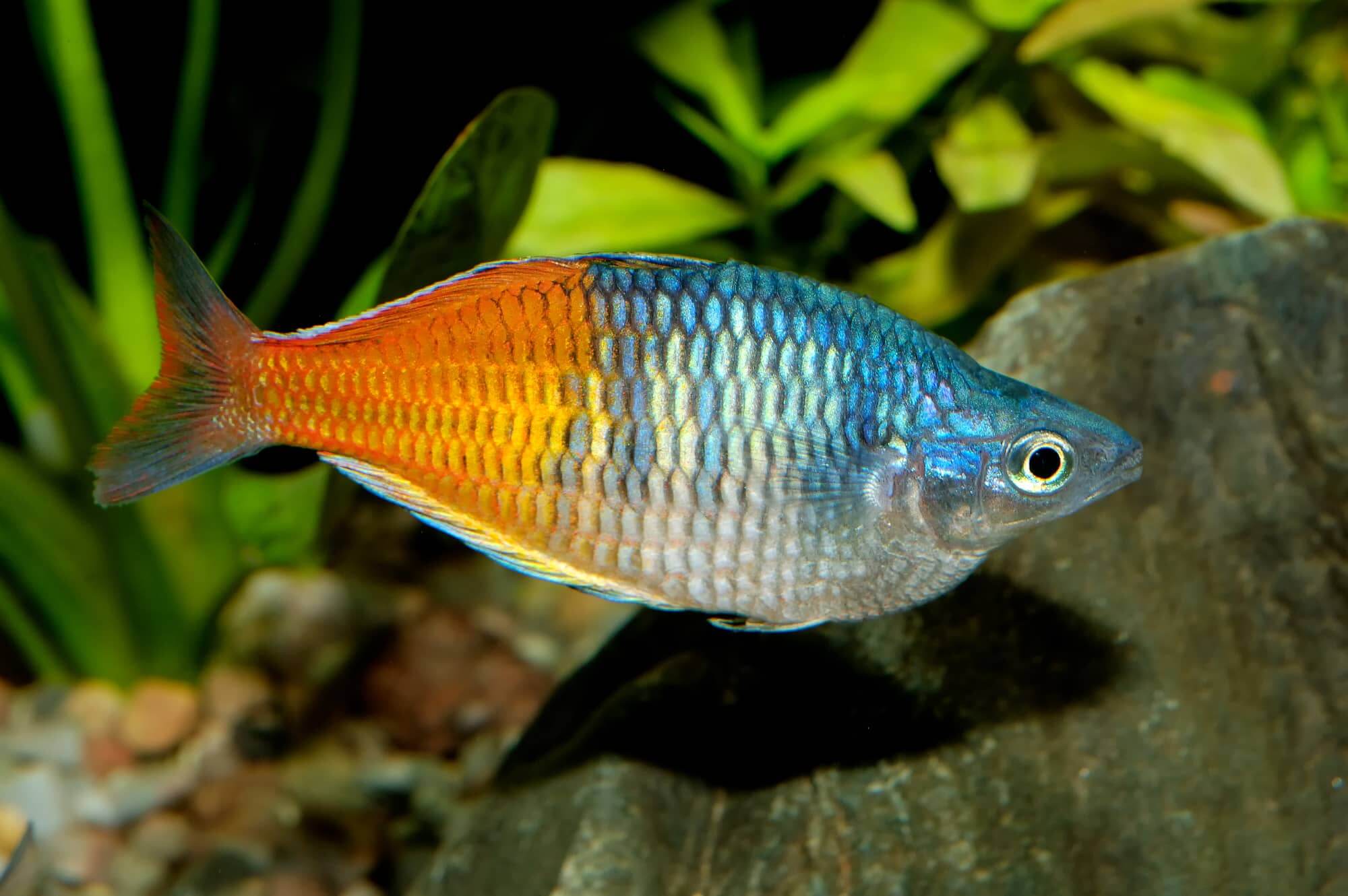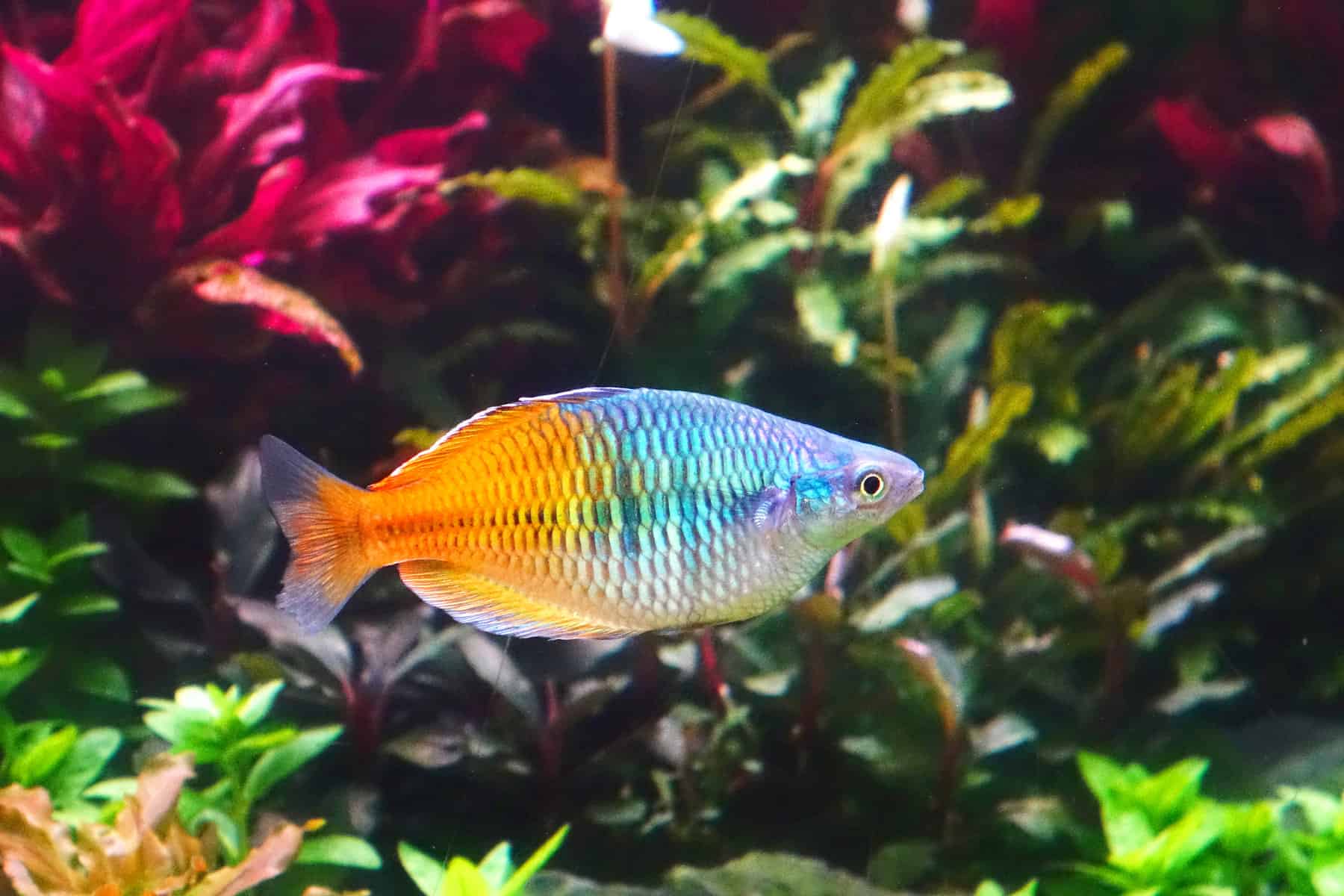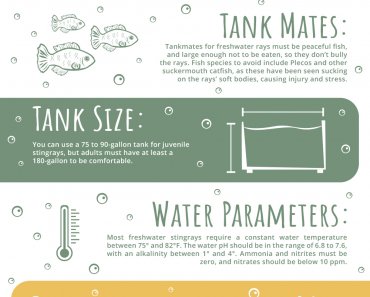Rainbow fish are beautiful and energetic tropical fish that are often kept in community tanks with other community fish. But some fish keepers have reported problems with aggression in rainbow fish, especially from males that can get territorial at breeding time.
Here we’re going to look at which species of rainbow fish are more prone to fighting, some of the reasons that rainbow fish become aggressive, and how you can prevent them from attacking or bullying your other fish.
Introducing Rainbow Fish
Rainbow fish are not a single species, but a family of colorful, tropical freshwater fish from Australia, New Guinea, Sulawesi, and Madagascar. Most rainbow fish are between 2.5-5 inches in length, but the largest species can reach up to 8 inches.
Their colorful appearance, active nature, and relatively peaceful temperament have made them popular in the aquarium trade for tropical community tanks, although there are some exceptions!
Aggression in Different Types of Rainbow Fish
Some of the most popular types of rainbowfish include Dwarf Neon Rainbowfish, Turquoise Rainbowfish, Red Rainbowfish, Threadfin Rainbowfish, Red Irian Rainbowfish, Murray River rainbowfish (aka. Australian rainbowfish), and the Lake Tebera Rainbowfish.
Each species of rainbow fish has its own temperament, but there is a tendency for males to become more aggressive during the breeding season, or when kept in groups that are too small or don’t have enough females.
Boesemani Rainbowfish, Celebes Rainbowfish, and especially the Lake Kutubu Rainbowfish (aka. Turquoise Rainbowfish), and Banded Rainbowfish have a reputation for being particularly aggressive and sometimes nipping the fins of other fish.
Causes For Rainbow Fish Aggression
Breeding Season Aggression
As with all animals, one of the top priorities for rainbow fish is to reproduce. Each male wants to father the next generation’s offspring and may fight with other males to become the dominant fish and win mating rights.
This breeding competition can be especially pronounced when there is a small tank with not enough hiding places, and when there are not enough females for every male.
Stress From a Small Group
All kinds of rainbow fish are schooling fish that need to be kept in groups of 6 or more to remain happy and healthy.
When schooling fish are kept in groups that are too small, they become stressed and anxious, and react either by becoming very timid and hiding or by becoming aggressive toward their tank mates.
In the case of rainbow fish, they nearly always become aggressive and may nip at the fins or even launch attacks on other tank members, big or small.
Not Enough Hiding Places
If one or two of your male rainbow fish are becoming aggressive, your other fish must have spaces where they can retreat to stay out of harm’s way.
If there’s nowhere to hide, your dominant rainbow fish may see the other fish as a constant challenge to his supremacy and continue to attack or harass them.
Feeding Competition
As incredibly fast, active swimmers of the middle to upper water layers, rainbow fish love to be the first to get to any fish food that’s placed in the water.
If other fish try to get to the food first, the rainbow fish may resent them for the feeding competition and bully them out of the way.
Overstocking
All of the above potential problems can be made much more likely and more severe by overstocking.
Because they’re such an energetic type of fish, rainbow fish need plenty of room to exert their energy, and will become frustrated and irritable if they don’t have enough free swimming space.
How To Reduce Aggression in Rainbow Fish

There are several ways to reduce aggression in rainbow fish, let’s take a look at some of the best.
Choose a More Peaceful Type of Rainbow Fish
If you haven’t got your rainbow fish yet, then choosing the right species is one of the most important ways to reduce the likelihood of aggression in the tank.
As mentioned earlier, Boesemani Rainbowfish, Celebes Rainbowfish, and especially the Lake Kutubu rainbowfish and Banded Rainbowfish are particularly prone to aggressive behavior. If you have any delicate tank mates, these are the species to avoid.
Keep the Right Male: Female Ratio
Since breeding excessive breeding aggression is usually caused by there not being enough female rainbow fish for each male, you need to get the male: female ratio of your school right.
In most circumstances, a good sex ratio for rainbow fish would be 2 males to every 3 females. Having more females than males increases the mating opportunities for males and lessens the chances of the strongest male aggressively dominating the tank.
Feed Other Fish Separately or With Sinking Food
If your other fish are suffering from rainbow fish aggression during feeding times, it may be helpful to feed more docile fish separately.
Simply feed your rainbow fish at one end of the fish tank. When they’re busy eating, feed your other fish at the other end. You’ll have to be fast because rainbow fish can finish their meal quickly and head over to the other side of the tank for seconds!
Another strategy is to feed your fish with food that sinks. Since rainbow fish are feisty surface–mid layer feeders, they can easily beat other fish to food that floats at the surface.
Foods that sink such as sinking pellets and frozen foods, however, get dispersed over greater areas and depths in the aquarium, making it easy for more timid fish species to get their fill.
Provide Plenty of Hiding Place
You can reduce the risk of conflicts between your rainbow fish by providing plenty of hiding places in your aquarium. If a particular fish in the tank is getting bullied, it must have a safe refuge that it can retreat to stay out of harm’s way.
Observing fish over many years has taught me that when a fish hides, it’s like a submissive signal to the others that it doesn’t want to fight, that it’s not challenging the tank’s pecking order. Once hidden, they’re normally left alone.
Providing dense aquarium plants such as Amazon sword and Java fern allows submissive rainbow fish as well as other fish species to retreat from an aggressive male rainbow fish that’s trying to dominate the open water territory.
Get a Larger Tank
Rainbow fish need a lot of free swimming space to feel content and peaceful. The normal rule of thumb for calculating tank size is to provide one gallon of water volume for each inch of fish.
Let’s take the Boesemani Rainbowfish that grows to 4 inches long. Since rainbow fish should never be kept in groups of less than 6, I’d recommend buying at least 8 of them, to provide insurance in case there are any deaths in the group.
If we multiply 8 x 4, we see that they’ll need at least 32 gallons of water to be happy. But since rainbow fish are especially active fish, I’d give them more room – so a 40-gallon tank for 8 fish. If you want to add other fish species, you’ll have to use the same calculations to increase the fish tank size further.
Turn up the Water Current!
An interesting trick that some aquarists swear by is increasing the water current in the aquarium to curb aggression.
How does this work? It might be a combination of factors. A filter with a high output delivers a higher oxygen concentration to the water and an increased rate of filtration. These cleaner water conditions may help the fish to feel more relaxed and therefore less likely to trouble their neighbors.
Also, if the water is too stagnant, fish may become bored and go looking for stimulation. A fast water current gives the fish something to swim against, and an opportunity to exert energy in other ways than bothering other fish.
Good Tank Mates for Rainbow Fish

Another piece of the puzzle for creating a peaceful tank environment for rainbowfish is choosing the right tank mates. While most rainbow fish are moderately peaceful fish, their tank mates need to also be friendly fish species that are robust enough to deal with any potential aggression.
Smaller tetras like neon tetras could get overwhelmed by the frenetic activity and occasional aggression of rainbow fish, and species with long fins like guppies and betta fish are better avoided to prevent fin-nipping problems.
Better choices include danios, rasboras, barbs, larger tetras, and peaceful cichlids such as ram cichlids and kribensis. Clean-up crew bottom dwellers like catfish and loaches also tend to be less likely to enter conflicts with rainbow fish since they inhabit a different layer of the tank.
Conclusion
Rainbow fish are often touted as ideal community tank fish, but several aquarists have reported problems with aggression. The potential for territorial behavior is worsened when the wrong species of rainbow fish is chosen, or when they’re kept in unsuitable conditions.
You can lessen the chances of rainbow fish aggression by improving their environment, keeping them in large schools, and choosing peaceful, robust tank mates that can live alongside them harmoniously.

























